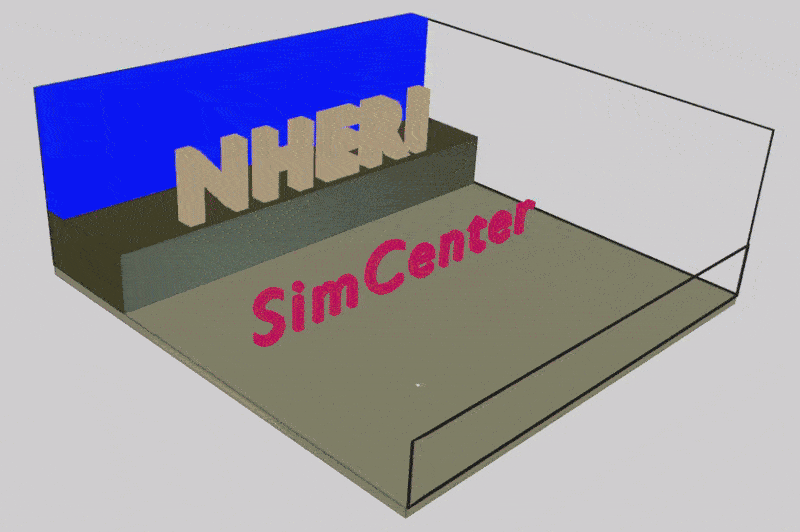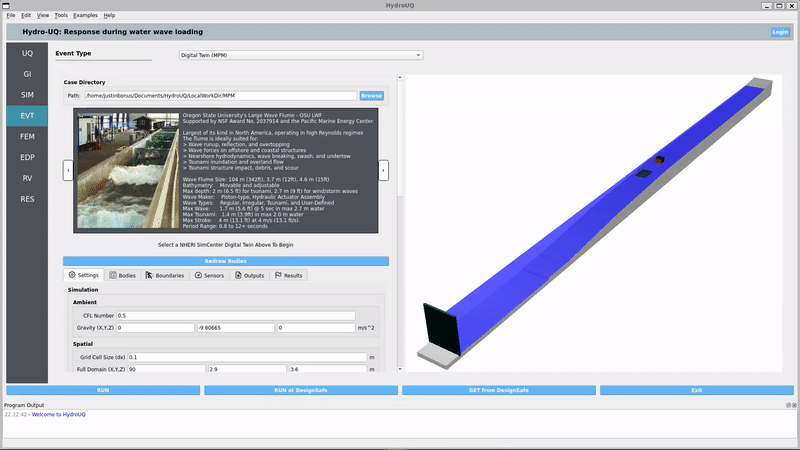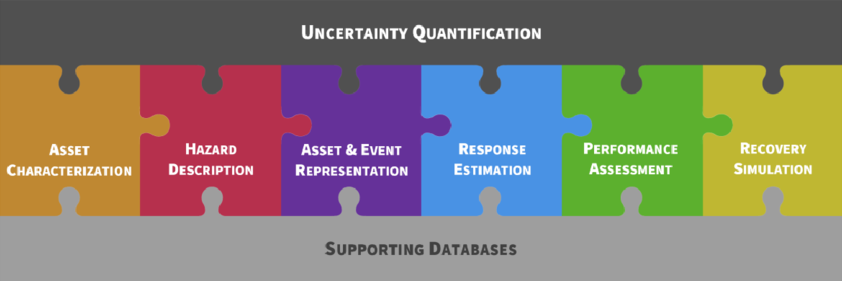HydroUQ
#
HydroUQ - Desktop App
Water-borne Hazards Engineering with Uncertainty Quantification
Frank McKenna, Justin Bonus, Ajay Harish, Nicolette Lewis, Pedro Arduino
NHERI SimCenter, 2020-2025


Why Use HydroUQ?
The HydroUQ desktop application is a user-facing portal for cutting-edge engineering workflows targeting tsunami and storm-surge demands on structures. It is a free, open-source, graphical software for simulating a structures’s response with uncertainty quantification (UQ) during water-borne natural hazard loading. The application’s interchangeable workflow allows you to swap between popular uncertainty quantification methods (e.g. Forward, Sensitivity, Reliability) to upgrade your previously deterministic models to probabilistic ones. Modular design lets you drop-in your own building models (SIM), event types (EVT), nonlinear structural analysis (FEM), engineering demand parameters (EDP), and more.
Capabilities
- Drop-in uncertainty quantification (UQ) methods like forward propagation, sensitivity, and reliability analysis onto previously deterministic computational fluid dynamics (CFD) models using
SimCenter UQand/orDakotabackends - Model experiments from validated wave flume digital twin
- Bathymetry/topography of the ocean floor and land surface for accurate wave propagation
- Shallow-water solutions (e.g.,
GeoClaw) as boundary conditions to 3D CFD (e.g.,OpenFOAM) - Capture high-fiedlity wave-driven debris motion, impacts, damming, and deposition.
- User-defined buildings for wave loading input and structural response output
- Design structures including Multi-degree-of-freedom (
MDOF) model, steel building model,OpenSeesmodels, andOpenSeesPymodels - Output probabilistic building responses, velocities and pressure at any point in the fluid domain
- Supports multiscale coupling by resolving areas of interest with a 2D shallow water solver (e.g.,
GeoClaw) and a 3D CFD solver (e.g.,OpenFOAM) and bridging them at an interface. - Model elasto-plastic, topology-changing debris and/or structures under wave-loads with the Material Point Method (
MPM)
Quick Links
- Download Application
- Step-by-Step Examples
- Documentation & Guides
- Overview Web-Page
- Forum & Feature Requests
Data-Repositories
Comparison data of ClaymoreUW MPM to DualSPHysics SPH and STAR-CCM+ CFD against stochastic experiments by Goserberg et al. 2016. For comparison details, see Bonus et al. 2025, “Tsunami Debris Motion and Loads in a Scaled Port Setting: Comparative Analysis of Three State-of-the-Art Numerical Methods Against Experiments”, published in Coastal Engineering.
DesignSafe DataDepot Repository
Citing HydroUQ
If you use HydroUQ in your research, please cite our software as:
@software{McKennaBonusHarishLewis2024,
author = {Frank McKenna and Justin Bonus and Ajay Harish and Nicolette Lewis},
title = {HydroUQ},
year = {2024},
month = {4},
note = {NHERI-SimCenter/HydroUQ: Version 3.1.0 (v3.1.0). Zenodo.},
url = {https://zenodo.org/records/10902090},
doi = {10.5281/zenodo.10902090}
}
include the NHERI SimCenter’s workflow architecture 
@Article{Deierlein2020,
author={Deierlein, Gregory G. and McKenna, Frank and Zsarnóczay, Adam and Kijewski-Correa, Tracy and Kareem, Ahsan and Elhaddad, Wael and Lowes, Laura and Schoettler, Matthew J. and Govindjee, Sanjay},
title={A Cloud-Enabled Application Framework for Simulating Regional-Scale Impacts of Natural Hazards on the Built Environment},
journal={Frontiers in Built Environment},
volume={6},
year={2020},
url={https://www.frontiersin.org/articles/10.3389/fbuil.2020.558706},
doi={10.3389/fbuil.2020.558706},
issn={2297-3362},
}
and cite the underlying multi-physics engine, ClaymoreUW , as:
@software{bonus_2025_15128706,
author = {Bonus, Justin and
Arduino, Pedro},
title = {ClaymoreUW},
month = apr,
year = 2025,
publisher = {Zenodo},
version = {1.0.0},
doi = {10.5281/zenodo.15128706},
url = {https://doi.org/10.5281/zenodo.15128706},
swhid = {swh:1:dir:9cbe98d28ea95b5758a235e84b601ce1214c6192
;origin=https://doi.org/10.5281/zenodo.15128705;vi
sit=swh:1:snp:a6c72ffcb71d94a657a09c1263c1765090f4
6ae5;anchor=swh:1:rel:0ae156dadd4f4ba1268431ec7205
4b9d8b6cc328;path=claymore-master
},
}
SimCenter Eco-System
The challenges of natural hazards engineering are addressed by the NHERI SimCenter through a suite of applications that provide cutting-edge tools for researchers, practitioners, and stakeholders. The applications are designed to work together to provide a comprehensive solution for natural hazards engineering. A puzzle-piece diagram of the SimCenter ecosystem is shown below:
In reality, this is a software workflow representation of the PEER Performance-Based Earthquake Engineering (PBEE) framework that has been extended to include other natural hazards:
HydroUQ is just one part of the NHERI SimCenter ecosystem that provides cutting-edge open-source tools for natural hazards engineering. Tools like quoFEM, EE-UQ, WE-UQ, HydroUQ, PBE, and R2D work together to provide a comprehensive solution for natural hazards engineering. The SimCenter ecosytem forms a modular hierarchy that allows you to pick and choose tools in the workflow for your specific research or engineering problem.
<img width=60% align=”left” src=”https://raw.githubusercontent.com/JustinBonus/HydroUQ/mpm/images/SimCenter_Hierarchy.png” />
While R2D is the top-level application that provides a regional resilience assessment, EE-UQ, WE-UQ, and HydroUQ provide uncertainty quantified simulations for earthquake, wind, and water-borne natural hazards, respectively. quoFEM is the backend UQ functionality they use.
Additional tools, such as BRAILS and TInF, have special use-cases including AI-augmentation of building stock and creation of turbulent wind inflow for OpenFOAM CFD simulations.
All applications are free, open-source, and available for download on the DesignSafe-CI website. See the table below for more information on each application:
Getting Started
The HydroUQ application can be downloaded, installed, built, and launched on Windows, Mac, and Linux operating systems. With a free DesignSafe account, you can run HydroUQ simulations remotely on powerful supercomputers including Frontera, Lonestar6, and Stampede3.
Download HydroUQ
The HydroUQ desktop application is available for download on Windows and Mac operating systems from the DesignSafe-CI website at the HydroUQ Download Link.
Install HydroUQ
The HydroUQ installation instructions are available in the HydroUQ Installation Guide.
Build HydroUQ
The HydroUQ application can be built from source code on Windows, Mac, and Linux operating systems. The source code is available in this repository.
Clone the repository using the following command if the Github CLI is installed on your system:
git clone https://github.com/NHERI-SimCenter/HydroUQ.git
Otherwise, you can clone the repository on this page by clicking on the green Code button and then clicking on Download ZIP. Extract the downloaded ZIP file to a location on your system.
Instructions on building the HydroUQ application from downloaded source code are available in the HydroUQ How-To-Build Guide
Launch HydroUQ
The HydroUQ application can be run by executing the Hydro_UQ executable file. The instructions to run the HydroUQ application are available in the HydroUQ Documentation
Run HydroUQ Remotely
With a free DesignSafe account you can use the HydroUQ desktop app to launch a remote job to run simulations on powerful supercomputers with ease.
Available systems are the Frontera, Lonestar6, and Stampede3 supercomputers. Systems are located at the Texas Advanced Computing Center (TACC) and made available to you through NSF’s NHERI DesignSafe-CI, the cyberinfrastructure provider for NHERI.
Get Involved
HydroUQ is an open-source project developed for practitioners, researchers, students, and stakeholders by our team of experts at the NHERI SimCenter. We welcome contributions from the community to help improve the application and add new features.
Contributing to HydroUQ
Interested in contributing to the HydroUQ project? Find out how in the HydroUQ Contribution Guide.
Contact Us
Message us on the SimCenter Message Board for any questions, feature requests, or issues.
| Developer | Role | |
|---|---|---|
| Justin Bonus | bonus@berkeley.edu |  |
| Frank McKenna | fmckenna@berkeley.edu |  |
| Ajay Harish | ajay.harish@manchester.ac.uk |  |
| NHERI SimCenter | nheri-simcenter@berkeley.edu |  |
Sign-up for Updates
Stay up-to-date with the latest news, updates, and releases with the NHERI Newsletter and the SimCenter Newsletter newsletters.
Release License
HydroUQ is released as an open-source research application under a BSD 2-Clause License
Acknowledgement
This material is based upon work supported by the National Science Foundation under Grant No. 1612843 and No. 2131111. Any opinions, findings, conclusions or recommendations expressed in this material are those of the author(s) and do not necessarily reflect the views of the U.S. National Science Foundation.





























